 How to Recruit Volunteers Using
How to Recruit Volunteers Using
Content Marketing
How do we recruit volunteers in the best way for our nonprofit? If you find yourself asking this question often, you’re not alone.
In our annual Volunteer Management Progress Report survey, volunteer recruitment is the top challenge noted by respondents for five years running. Other barriers to success pale in comparison.
We asked them to share their “#1 biggest challenge” in their own words, not based on a list we provided.
The same five issues have been most often cited over the past five years. They appear year after year, with a few slight changes in the order. But volunteer recruitment is ALWAYS the top challenge.
Top Five Challenges of Volunteer Managers
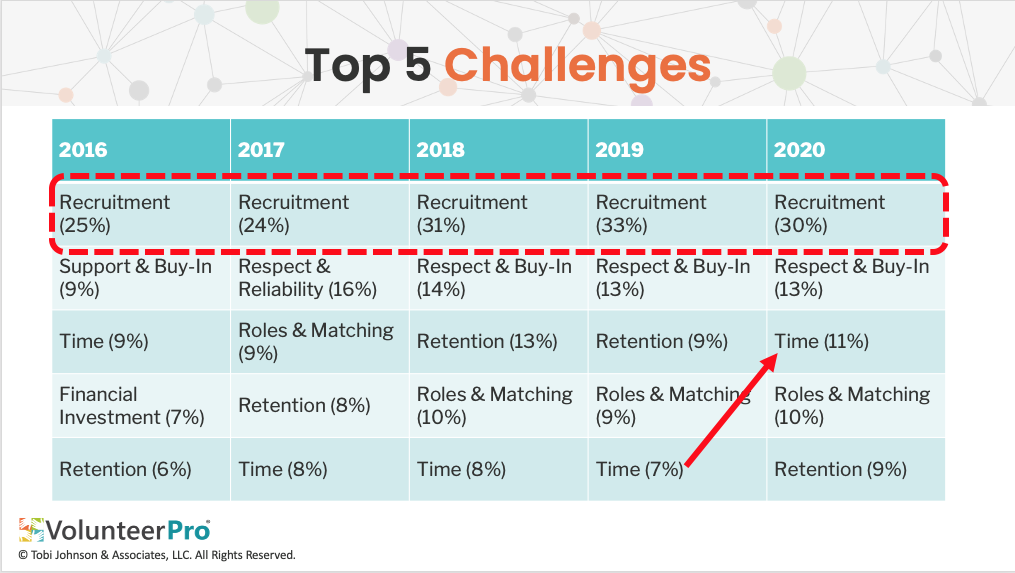
Below were our top five results for 2020 (with notes on the change from the year before)
- Recruitment – Finding the right volunteers for specific roles and needs (30%, dropped 3% from 2019)
- Respect and Buy-In – From co-workers, executives, and volunteers (13% stayed the same)
- Time – Managing competing and multiple priorities (11%, moved from last place to third place, gained 4%)
- Roles & Matching – Designing roles & matching volunteer and organization’s needs (10%, gained 1%)
- Retention – Longer time volunteers and fulfilling commitments to service (9%, dropped to fifth place, but still the same percentage of respondents noted it in 2019)
While other challenges were noted, these consistently fall in the top five places.
So, what gives?
Why do organizations struggle to attract volunteers?
It might help to understand who volunteers and how volunteers become involved in the first place.
How Do Volunteers Get Involved?
Between September 2014 and September 2015 (the most recent data we have in the US), most volunteers were involved with either one or two organizations—72% and 18.3%, respectively.
People with higher educational attainment were more likely to volunteer for multiple organizations than were those with less education.
How Volunteers Become Involved
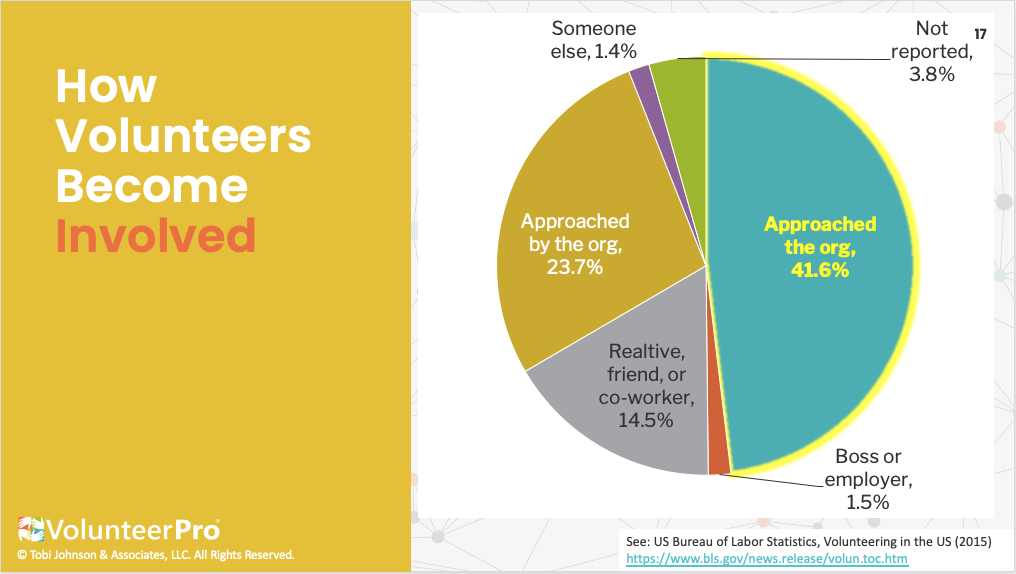
The proportion of volunteers who became involved with their main organization after being asked to volunteer (41.2%) was about the same as the proportion who became involved on their own (41.6%) — that is, those who approached the organization. Those who were asked to volunteer were most often asked by someone in the organization.
Recent research from the NVCO in the UK, offers an even more nuanced look and how people get involved in volunteerism.
Like data in the US, they also found that those with higher educational achievement were more likely to have volunteered recently. 48% of respondents had a degree of some kind, and 20% who volunteered recently had no degree.
In addition, socioeconomic status correlated with volunteer participation. Those from higher socio-economic status were more likely to have volunteered recently and are more likely to be frequent volunteers. In addition, those from lower socio-economic groups were most likely to say they had never volunteered.
Barriers to Volunteer Involvement
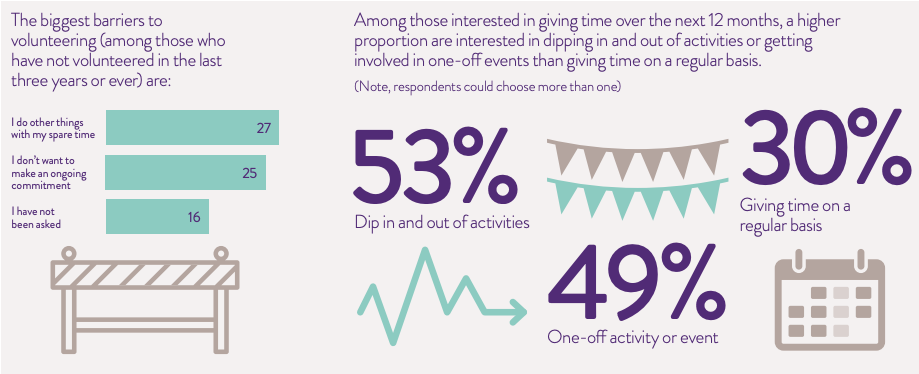
Source: NCVO, Time Well Spent: A National Survey on the Volunteering Experience
While it might be easy to blame the lack of volunteerism on a general lack of time, the data shows something more subtle. 27% of those surveys noted that the reason they don’t volunteer is because they simply choose to do other things with their time. Another 25% don’t want to make an ongoing commitment.
In addition, for those who are interested in giving time, a higher proportion (53%) are interested in dipping in and out of activities or getting involved in one-off events (49%). Only 30% are interested in giving time on a regular basis. (Note: respondents could choose as many interests as they wanted).
Flexibility & Efficiency are Key for Volunteers
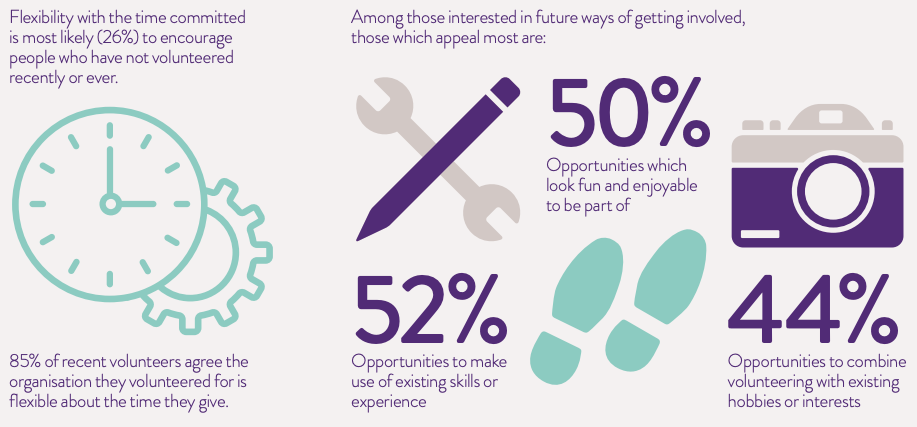
Source: NCVO, Time Well Spent: A National Survey on the Volunteering Experience
Potential supporters want volunteering to be convenient and fit in with their lives. Having flexibility with their time commitment and being asked directly are most likely to encourage those who have not volunteered recently, the survey shows.
However, potential volunteers might not even realize how flexible volunteering can be. 85% of existing volunteers agree that organizations are indeed flexible.
Further, the NCVO data shows that once they are involved, they are more likely to stay.
In fact, 80% of recent volunteers say they are likely to continue volunteering over the next year. 70% report they have already or would recommend volunteering to others.
The factors strongly related to volunteer retention and satisfaction in the NCVO research include
- enjoyment of the experience
- making a difference
- not feeling pressured
- not having too much of their time taken up
Clearly, volunteers value their time and don’t want it wasted.
But what’s even more interesting is that many people may not actually understand what’s involved in volunteering and how the time commitment might be tailored to their needs.
Hence, fewer reach out to organizations to contribute to the first place.
How to Recruit Volunteers: Implications for Practice
The research discussed above from both the UK and the US, offer some interesting ways to think about how to recruit volunteers in today’s world and how we might shift how we present opportunities to the public.
Two key implications emerge from the data discussed above –
1. A significant number of volunteers are the ones who initiate contact with a potential organization
2. Many in the public don’t have a clear picture of what volunteerism entails and how it can meet their needs.
When it comes to successful volunteer recruitment, what does this mean?
In marketing terms, this means two things need attention – 1) brand presence and 2) clear positioning and framing of messaging.
First, if volunteers drive much of the initial interest, then organizations need to achieve high levels of brand awareness and trust in their communities. They also need to rank in online organic search.
In other words, they need to show up on the first page of Google when prospective volunteers are seeking potential opportunities. This will ensure that volunteers who are ready to commit time can connect quickly.
Second, organizations need to both offer flexible options and explain them in clear language to prospective volunteers. Flexibility is a key benefit for today’s volunteers. It’s also a key objection to acting.
In other words, role descriptions, calls to action, stories and testimonials, and other volunteer-centric content needs to highlight how the experience can be tailored to the volunteer’s personal time constraints.
This may mean that organizations, on their part, may need to get creative about how they involve volunteers and adjust their expectations around how long they can expect volunteers to stay.
Expecting a 6-month or annual commitment may be much more palatable at the beginning than a three-year expectation. And, if the volunteer enjoys the experience and finds it meaningful, they may stay longer anyway.
Search Engine Optimization (SEO): Keywords Help You Recruit Volunteers Online
The best place to find volunteers is where they hang out.
And, if they are like most people around the world, the data shows they spend a LOT of time on the internet. And, 88% of smartphone users use their device to conduct searches.
So, what happens when they are searching for volunteer opportunities?
If they don’t find anything on the first page of Google, they most likely give up.
Here are some sobering stats about internet browsing:
- Google owns 88% of the market share of search traffic
- On average 53% of all traffic to websites comes from an organic Google search
- Half (49%) of Google searches result in no click at all
- 75% of people never scroll past the first page of search engines
- On the first page alone, the first five organic results account for over 67% of all the clicks
- The results from positions 6 to 10 account for only 3.73%
So, capturing the nearly half of potential volunteers that are looking for opportunities means getting your posting to the top of Google’s first search page.
This requires strategy and persistence.
Website Structure and Keywords

If you’re wondering which words your potential volunteers are using to find you online, the best place to start is with Google itself. Check the keyword suggestions that come up during an organic search – in the drop down auto-fill and at the bottom of the page.
Free and low-cost tools like Ubersuggest can also give you keyword ideas. They can also tell you how hard it is to rank for a particular keyword in simple terms. This is very helpful when comparing keywords.
Also, listen to volunteers and ask new recruits how they heard about you. If they say they found you online, ask them specifically what they were searching for. You will often learn that the words they use (e.g., “volunteer with animals”) are different than those that you use (e.g., animal welfare volunteer”).
Once you have a list of keywords you’d like to rank for on Google, either update existing pages (one keyword per page) or add pages (could be informational page, blog post, etc.).
You only want one page on your website to be assigned to a specific keyword (otherwise you compete with yourself). So, use variations of your keyword for future pages (e.g., “volunteer dog walker,” “how to volunteer with dogs,” tips for dog walking volunteers,” “volunteer dog walker openings,” etc.)
When you build your pages (or your marketing person does), make sure you include the keyword at these points of the copy.
- Email Subject Line (if you are sending people a link to the page)
- Newsletter Article or Blog Headings
- Landing Page Heading (the main title)
- Landing Page Subheading (the text under the main title)
- First Sentence of Content
- Call to Action (the button or text right above it)
- Image Description/Alt Tag (all images on the page should include it, along with a description of the image)
- Webpage Meta Description (the description that shows up under the link in the organic search results in Google)
- In Body Text (don’t overdo it, but it should show up a few times)
By taking a purposeful approach to your content, the Google indexing bots will more likely find you and the algorithm will rate you as highly relevant content for that keyword.
But have patience. Ranking takes trial and error and time (sometimes months) to get to page one of Google.
How to Recruit Volunteers by Perfecting Your Offer
When it comes to recruiting volunteers, the lack of flexibility in the time commitment is a key objection.
Organizations must offer flexible options and explain them in clear language to prospective recruits as a key benefit.
And this benefit should be repeated throughout position descriptions, calls to action, stories and testimonials, and other content that appears on the website.
The messaging must highlight how the experiences on offer can be tailored to the volunteer’s personal needs.
Every offer, whether it be an invitation to buy or a call to serve is accompanied by 3-5 common objections. The research above tells us that key concerns (expressed as elements of satisfaction) for volunteers are:
- an enjoyable experience
- the ability to make a difference
- not feeling pressured
- and being able to commit a reasonable amount of time that fits their schedule
Review your current volunteer recruitment materials and website against the four elements above. How well do you counter the objections to each?
If not well, create a list of 3-5 key talking points and include them throughout your volunteer recruitment materials.
Talking Points in a Nutshell

Do you have volunteer success stories and volunteer testimonials featured that “prove” that these are present?
If you don’t, consider setting up interviews with current volunteers and ask the following:
- What does this cause mean to you? What inspires you?
- Is volunteering with us meaningful? Why?
- Why does volunteering make sense in your world? How do you fit it into your schedule?
- Think about a recent volunteer experience with us, what stood out as highlights for you? Why?
- What do you look forward to when you have an upcoming shift scheduled?
- What’s most fun about volunteering with us?
- Have you ever needed more flexibility with your volunteer experience here? What happened?
- If I could wave a magic wand and create a volunteer experience that was perfect for you, what would it look like?
You will want to share their experiences in their own words. Make sure to record each volunteer interview. Otherwise, you will not be able to capture their exact verbiage.
Then, create short success stories or pull out particularly compelling quotes that address each objection.
Not everything you hear will be glowing praise. Be ready to learn and grow from the experience, too.
When interviewing volunteers and they bring up concerns, remember the following:
- Make sure you really understand what the objection is – People are famously indirect. If you suspect an issue, point out that you sense a concern and would like to explore it further. Then, ask things like “What is your biggest concern?” or “Can you explain what worries you?”
- Pinpoint what’s in the way – You may understand what worries them, but still not understand the barrier. Ask things like “What would need to change for you to feel better about your experience with us?”
- Validate their concerns – People often have valid fears and reasons why they hesitate to share their issues. No one really enjoys conflict, but if they share, they want to be heard. Repeat back what you heard them say to let them know you’re listening. Do this before you respond to their objections with alternatives or point out something they may have overlooked.
If volunteers know they are truly heard, they will be more likely to work with you, not against you, to resolve the problem.
So, how do you recruit volunteers effectively to partner with your nonprofit?
While we have written about several strategies in our blogs, the research tells us that by focusing on two main areas we are most likely to get traction.
1. Since many volunteers initiate contact, make sure you show up where they search for opportunities and work hard to show up at the top of the search results for keywords related to your volunteer opportunities.
2. Because many people are nervous about the time commitment related to volunteerism, communicate a clear picture of what volunteerism entails and make sure you include a range of hours and schedules, as well as roles, where they can contribute their talents without making it appear overly onerous.
If you can begin to get traction on these two areas, you may just see an uptick on your volunteer conversions. And, once volunteers join, if you offer a meaningful experience that is sensitive to their needs, they’ll be more likely to stay and support you for years to come.
Discouraged by Your Volunteer Recruitment Efforts?
Learn How to Survive and Thrive with Our Free Guide
Looking for a pick-me-up to get you through tough times?
Download our Free Guide and read about how talented volunteer leadership professionals overcome challenges, stay motivated, stay positive and have fun, even when faced with a crisis.
You will leave with 20 tips that will keep you inspired and motivated, giving you the ability to lift your community with you as you focus on what you are here to do: build a thriving support system for your nonprofit!
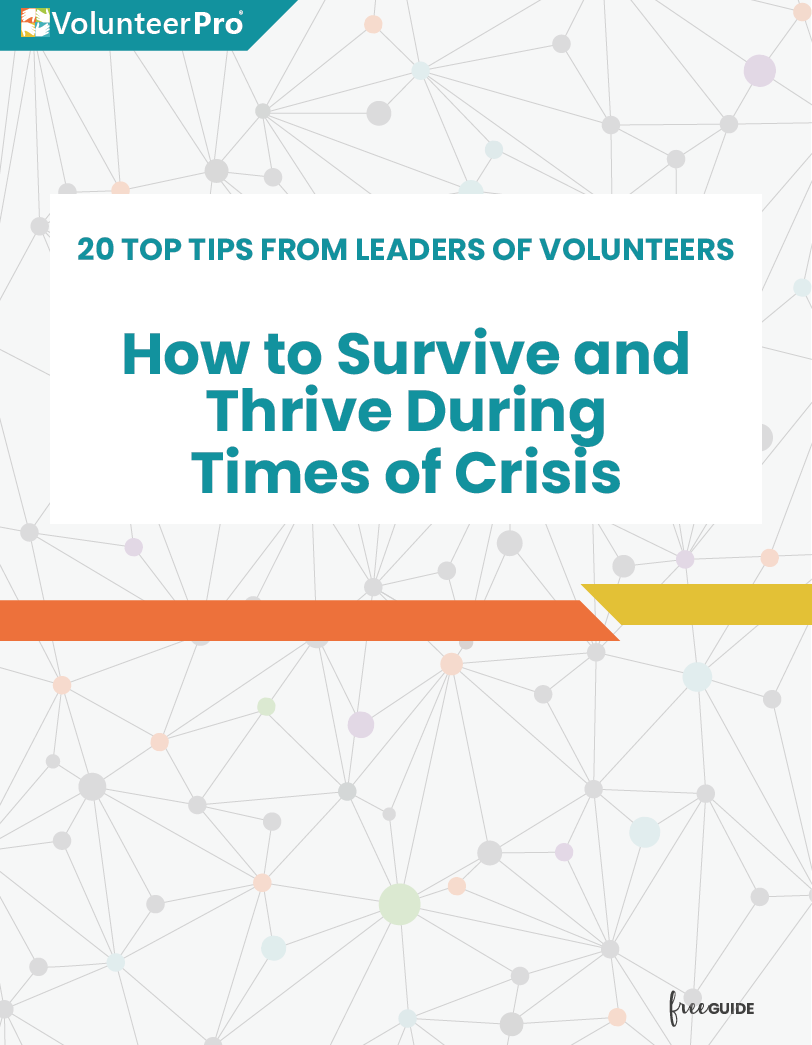
[FREE GUIDE] 20 Top Tips from Leaders of Volunteers:
How to Survive and Thrive During Times of Crisis
26 pages of inspiration from leaders who walk the talk.
Learn what your peers have to say about the following four themes:
- Overcoming Challenges: You can do Hard Things
- Mindfulness: Good Vibes Only
- Stay Motivated & Do Good Work
- Be Yourself: Have Fun and Make a Difference








Leave A Comment